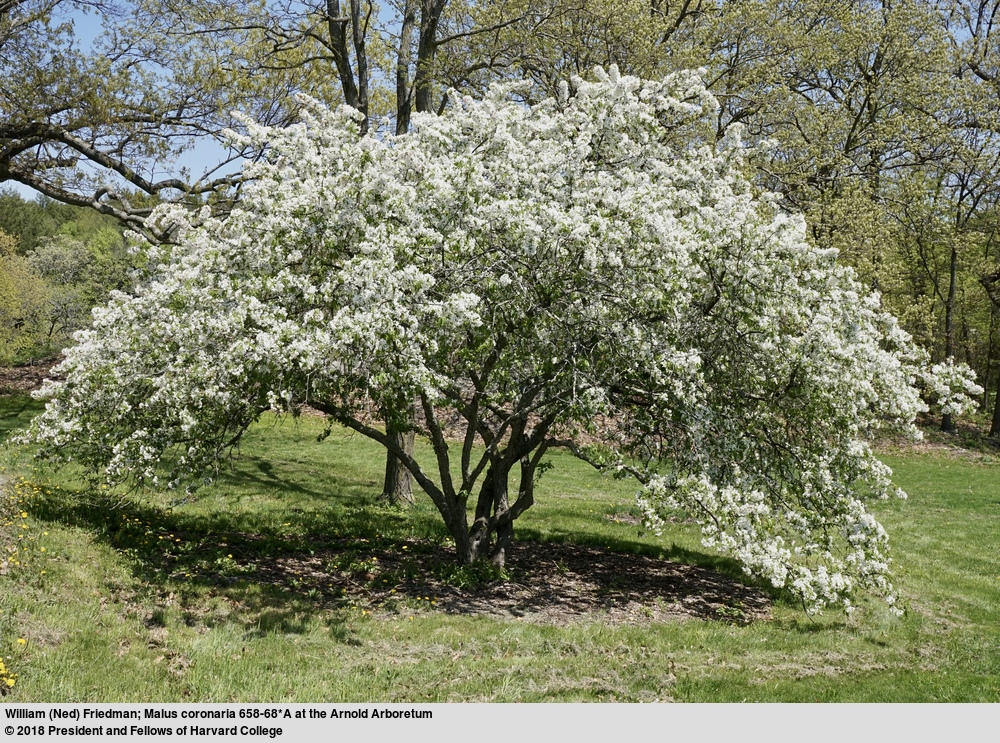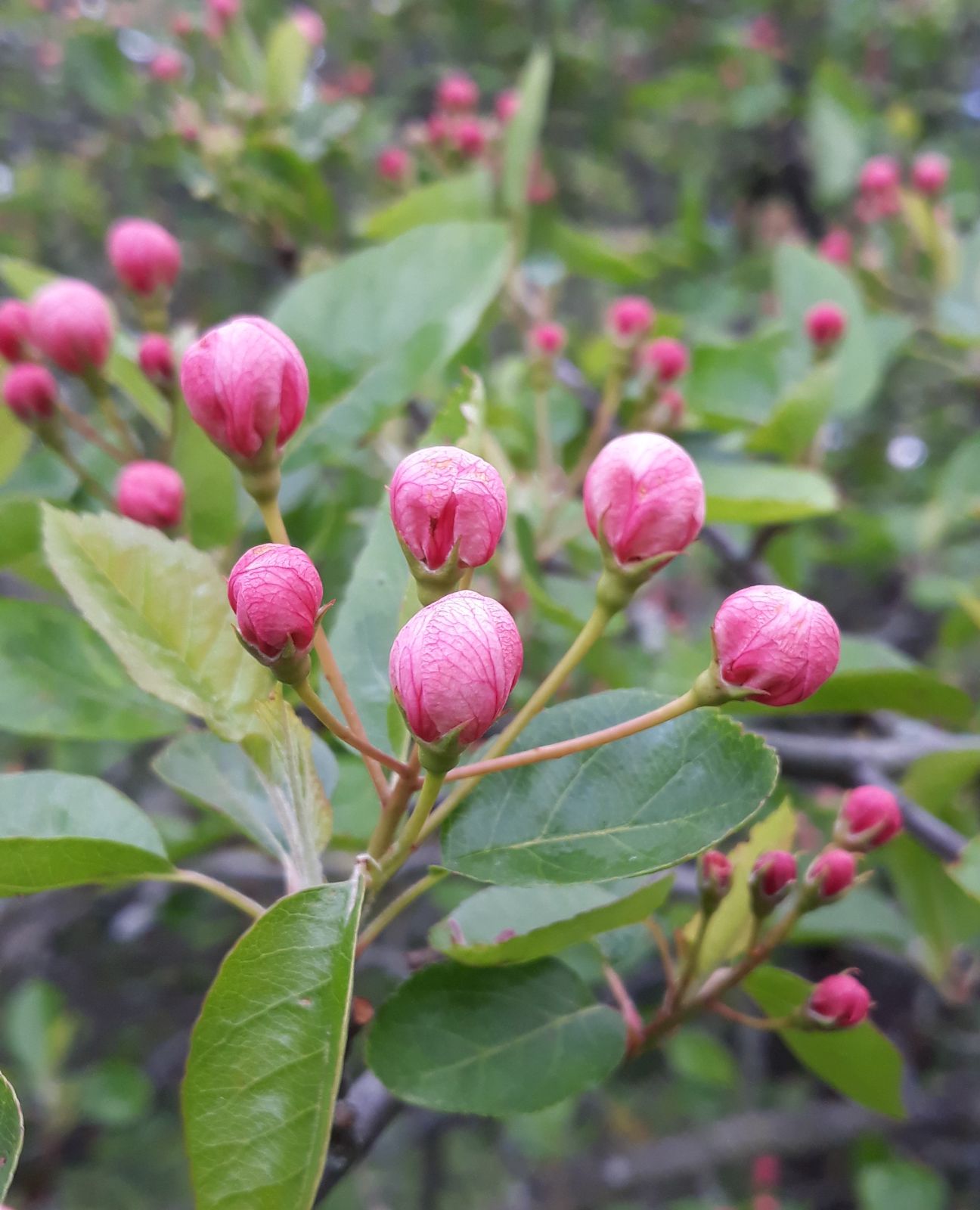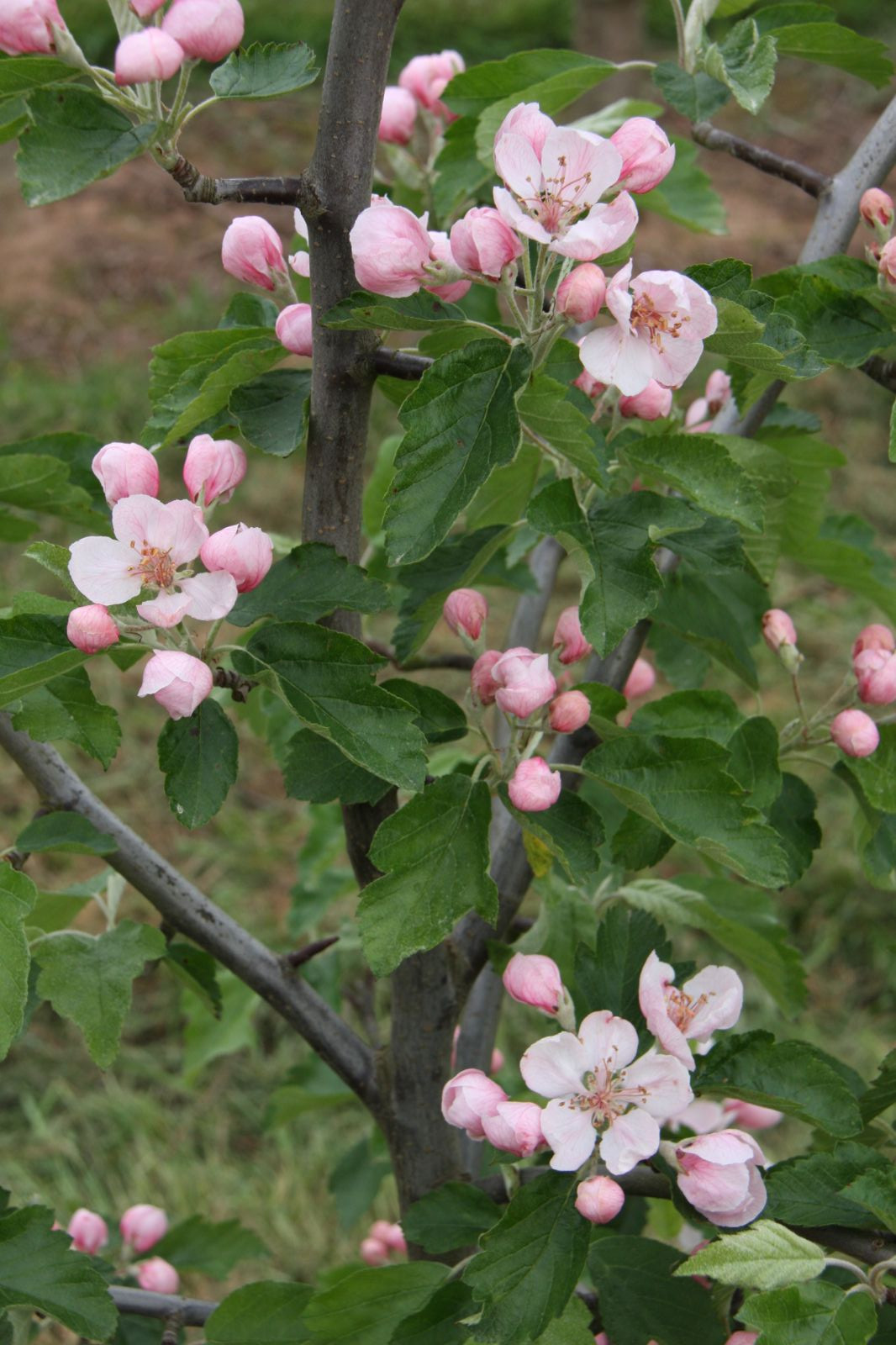Malus coronaria
Sponsor
Kindly sponsored by
Francine: 'after many informative Tours and Study Days with the IDS I feel it only fitting to help and promote such a wonderful organisation'
Credits
Julian Sutton (species), Nick Dunn (cultivars) (2021)
Recommended citation
Sutton, J. & Dunn, N. (2021), 'Malus coronaria' from the website Trees and Shrubs Online (treesandshrubsonline.
Genus
Common Names
- American Crab
- American Crabapple
- Garland Tree
Synonyms
- Pyrus coronaria L.
- Malus elongata (Rehder) Ashe
- Malus fragrans Rehder
- Malus glabrata Rehder
- Malus glaucescens Rehder
- Malus lancifolia Rehder
Infraspecifics
Other taxa in genus
- Malus × adstringens
- Malus angustifolia
- Malus × arnoldiana
- Malus asiatica
- Malus × astracanica
- Malus × atrosanguinea
- Malus baccata
- Malus bhutanica
- Malus × brevipes
- Malus chitralensis
- Malus crescimannoi
- Malus Cultivars A-B
- Malus Cultivars C
- Malus Cultivars D-F
- Malus Cultivars G-I
- Malus Cultivars J-K
- Malus Cultivars L-M
- Malus Cultivars N-Q
- Malus Cultivars R
- Malus Cultivars S
- Malus Cultivars T-Z
- Malus dasyphylla
- Malus × dawsoniana
- Malus domestica
- Malus doumeri
- Malus florentina
- Malus × floribunda
- Malus fusca
- Malus × gloriosa
- Malus halliana
- Malus × hartwigii
- Malus × heterophylla
- Malus honanensis
- Malus hupehensis
- Malus ioensis
- Malus kansuensis
- Malus kirghisorum
- Malus komarovii
- Malus × magdeburgensis
- Malus × micromalus
- Malus × moerlandsii
- Malus montana
- Malus ombrophila
- Malus orientalis
- Malus × platycarpa
- Malus praecox
- Malus prattii
- Malus prunifolia
- Malus × purpurea
- Malus × robusta
- Malus rockii
- Malus Rootstock Cultivars
- Malus Rosybloom Cultivars
- Malus × scheideckeri
- Malus sieversii
- Malus sikkimensis
- Malus × soulardii
- Malus spectabilis
- Malus spontanea
- Malus × sublobata
- Malus sylvestris
- Malus toringo
- Malus transitoria
- Malus trilobata
- Malus tschonoskii
- Malus turkmenorum
- Malus yunnanensis
- Malus × zumi
Small tree or shrub, 2.5–7.5(–10) m, with thorn-like spurs. Bark red-brown to grey, fissured and scaly with age. Branchlets brown to reddish, with hairy at first, sometimes conspicuously so. Buds red-brown, ovoid, 1–6 mm, scale margins tomentose. Leaves of vigorous shoots ovate to lanceolate, the blade (2.5–)4–8(–10) × (1.5–)4–6(–8) cm, base rounded to cordate or cuneate, margins very variably toothed and sometimes lobed, apex usually acute, sometimes rounded, glabrous except on the veins beneath, petiole (7–)10–25(–30) mm, sometimes hairy. Flowering shoot leaves smaller, blade (1.5–)2–6(–8.5) × (1–)1.5–4.5(–6) cm, petiole 5–15(–25) mm. Inflorescence a corymb of 4–6 flowers, peduncles absent, pedicels 2–3 cm, sometimes hairy. Flowers fragrant, 25–40 mm diameter, May in the wild; sepals triangular with acute or acuminate apex, 4–6 mm, hoary above, persistent; petals oblong to ovate, 12–18 mm, pink, sometimes ageing white; stamens 20, 10–13 mm, anthers pink or purple before dehiscence; styles 5, 10–12 mm, equalling or slightly exceeding the stamens. Fruit green or yellowish, acidic, September to October in the wild; depressed-globose, 1.5–3(–5.5) cm diameter, with erect sepals; stone cells abundant around the core. (Dickson 2015; Cullen et al. 2011; Bean 1981.)
Distribution Canada Ontario United States Eastern states, west to Wisconsin, Kansas and Louisiana; absent from Florida and New England.
Habitat Open woods, forest edges and diverse open habitats; 50–1000 m asl.
USDA Hardiness Zone 4-8
RHS Hardiness Rating H6
Conservation status Least concern (LC)
Typically a tree with a short trunk and a wide-spreading, open crown (Bean 1981), Malus coronaria is grown primarily for its flowers. Usefully late, in May or even early June in some areas, they can perfume the surrounding air. Linnaeus’ specific epithet, from the Latin coronaria (pertaining to a garland or crown) is appropriate.
The American Crab would have been among the trees first encountered by early European settlers. It was the first North American apple to be described scientifically, by Linnaeus in Species Plantarum (1753) as Pyrus coronaria, Miller transferring it to his new genus Malus in 1768. It was used as food and medicine by various indigenous American peoples. The fruits were dried for winter use by the Iroquois (Moerman 2020), mirroring Asian practice with other species (Juniper & Mabberley 2019), although uses for the hard wood are not recorded. This would presumably be the species used by settlers to make gear teeth for early Ontario grist mills (Arno & Hammerly 1977), and for tool handles (Juniper & Mabberley 2019).
This is a variable and taxonomically troublesome tree. Many taxa have been described at different levels over the years, none of them proving very clear cut. Most contemporary works follow – as we do – Elizabeth Dickson (Dickson 2015 and references therein) in recognizing two further, closely related species. M. angustifolia, with narrower leaves tapering at the base and usually more rounded at the apex, has a more southerly distribution than M. coronaria itself, whose core range is in the Great Lakes area. M. ioensis, with leaves persistently downy beneath, has a more westerly distribution centred on the Upper Mississippi Valley (Dickson 2015; Bean 1981; Kartesz 2015). These ‘species’ should be taken as morphological extremes, which intergrade and probably hybridize in nature. The situation is further complicated by polyploidy and hence presumably apomixis; M. coronaria is primarily a tetraploid, although diploid and triploid individuals have been reported (Dickson 2015; Höfer & Meister 2010; Kron & Husband 2009). Numerous botanical varieties have been described within M. coronaria; probably of little significance, they tend to be ignored or reduced to synonymy. Of them, only var. dasycalyx sees any horticultural use, and then only because some cultivars have been placed there.
An early introduction to European gardens, it was brought to England in 1724 and within 100 years or so was not uncommon in collections, even being claimed as naturalized at sites in Surrey and Berkshire (Loudon 1838). Perhaps eclipsed by later arrivals from Asia, it is not grown as widely as the beauty and fragrance of its flowers might deserve (Bean 1981). A specimen of 9 m × 69 cm was recorded in a private garden at Seagry, Wiltshire in 2005; a 12 m example at Westonbirt, Gloucestershire is now gone (The Tree Register 2020). The significant crab apple collection at Ness Botanic Gardens, Cheshire includes a young tree of Ontario provenance (T. Baxter pers. comm. 2020). There is an example at Meise Botanic Garden, Belgium, of wild origin (Meise Botanic Garden 2020).
The American Crab was cultivated in Pennsylvania by about 1750 (Jacobson 1996) and is more commonly seen in American than in European collections. Examples of arboreta in which it grows illustrate its adaptibility. In the Great Lakes region there are several examples of Illinois and Ohio provenance at the Morton Arboretum (Morton Arboretum 2020). On the west coast it grows in both the Pacific Northwest (Hoyt Arboretum 2020) and the Bay Area of California (University of California Botanical Garden 2020). In New England there are some attractive, larger specimens at the Arnold Arboretum; one, repropagated in 1963 from Bush & Sargent 7 of 1912, a Missouri collection, had a basal diameter of 61 cm in 2015 (Arnold Arboretum 2020). The American champion, beyond its native range in Orange County, VT, measured 11.6 m × 269 cm in 2019 (American Forests 2020).
Malus coronaria is particularly susceptible to rust (Dirr 2009). Cedar-apple rust (Gymnosporangium juniperi-virginianae) has Juniperus virginiana as an alternate host, and the two species should be well separated in North American plantings.
Where M. coronaria and M. domestica meet, the hybrid M. × platycarpa (q.v.) may arise, although its hybrid status is not universally accepted.
'Charlottae'
A wild, sparsely fruiting double, collected in Waukegan, IL by Edward and/or Charlotte de Wolf, 1902.
Growth Rate / Size: Small (<4 m)
Form/shape/habit: Broadly spreading
Foliage: Lobed, turning bronze in autumn
Flower colour: Soft pink
Flower size: Large (>4 cm)
Flower form: Semi-double to double, with 12–20 petals; fragrant
Flower season: Very late
Fruit size: Small (<2 cm), variable, sparse
Fruit shape: Round
Fruit colour: Green to green-yellow
Fruit season: Mid
Disease resistance/susceptibility: Low susceptibility
(Description duplicated under Malus Cultivars C ‘Charlottae’)
'Elk River'
A wild find near Elk River, MN, by A.W. Keays; introduced 1930 by Niels Hansen, South Dakota Agricultural Experiment Station.
Growth Rate / Size: Small (<4 m)
Form/shape/habit: Rounded, open
Foliage: Lobed, good autumn colours
Flower colour: Pink
Flower size: Large (>4 cm)
Flower form: Single
Flower season: Late
Fruit size: Large (>3 cm)
Fruit shape: Round, slightly ribbed
Fruit colour: Bright green
Fruit season: Mid, persistant
Disease resistance/susceptibility: Resistant
General notes: Most selections of M. coronaria are excellent ornamental trees, not least because of their lovely rich yellow and golden autumn leaf colours. This variety is particularly attractive for its persistent large bright green fruit (like miniature ‘Granny Smith’ apples) and large single pink flowers. Also excellent for making golden crab apple jelly.
(Description duplicated under Malus Cultivars D-F ‘Elk River’)
var. dasycalyx (Rehd.) Fern
Pedicel and backs of sepals hairy. From the south western Great Lakes area, and perhaps either a hybrid with M. ioensis, or an intergrading form. Its only horticultural significance is that ‘Charlottae’ probably belongs here; M. ioensis ‘Klehm’s Improved Bechtel’ has sometimes also been placed here (Jacobson 1996; Bean 1981).






